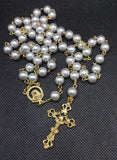Beautiful vintage light silver ivory glass faux pearl traditional Rosary.
Overview:
Details: a beautifully made Catholic Rosary using 59 smooth large round vintage light-silver-ivory coloured glass faux pearl beads.
Chains and links: gold
Centre-piece: Mater Dolorosa Our Lady of Sorrows in vintage gold with Sacred Heart of Jesus depicted on the back.
Crucifix: Vintage gold Lauretan / Loreto Cross. The beautifully decorated crucifix consists of an eight-pointed cross and a medallion with the image of the Lady of Loreto in the middle which is similar to the medal of the Order of the Knights of Loreto. A golden ribbon winds between the four arms of the cross. Members of the cathedral chapter of Loreto wore the cross suspended on a cord.
Rosary Length: 53cm
Rosary Weight: 46cm
Notes:
Our Lady of Sorrows, we call to mind the pain endured both by Christ on the Cross and Mary, as she watched her Son be crucified. We ask for the grace to join in that sorrow, so that we may awaken to what is truly important: Not the passing joys of this life, but the lasting joy of eternal life in Heaven.
The tradition of the shrine at Loreto goes back to the year 1291. As the last of the crusaders returned to Western Europe they brought with them a number of relics, objects of devotion and remembrances of holy shrines. It happened that the dwelling of the Blessed Virgin Mary, the house which both tradition and Christian devotion had maintained as the site of the appearance of the archangel Gabriel and therefore the Incarnation of our Savior, was moved from Nazareth to Christian Europe.


















